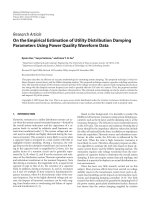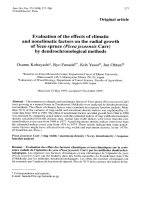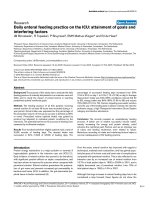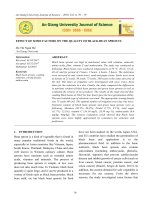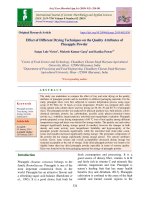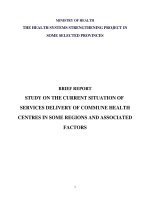on the quality factors of mems resonators doctor of philosophy major electronics engineering
Bạn đang xem bản rút gọn của tài liệu. Xem và tải ngay bản đầy đủ của tài liệu tại đây (6.33 MB, 92 trang )
Rr
marke
HAE ALDH
HERR
Dissertation for Doctor of Philosophy
MEMS 2838 3 oo ob YAS
On the Quality Factors of MEMS Resonators
Bae
Student: Chi-Cuong Nguyen
ew
de SS
Advisor: Wang-Long Li
AE AE
National Cheng Kung University
Department of Materials Science and Engineering
Tainan, Taiwan, R.O.C.
May 2017
PERM
106
#05
A
24
a
On the quality factors of MEMS Resonators
Chi-Cuong Nguyen
A dissertation submitted to the Department of
Materials Science and Engineering in partial
fulfillment of the requirement for the degree of
Doctor of Philosophy
National Cheng-Kung University
Department of Materials Science and Engineering
Tainan, Taiwan, Republic of China
Approved by
May 2017
Abstract
Contoling ofthe energy dissipation mechanisns and investigations of their physical
effects play key roles on the perfomeances of many microelectiomechanical system
(VEMS) resonators such os accelerators, aeicro gyroscopes, torsional rans,
ricrophones used in many applications such as sensns, ectustox, tansluctos, and
energy havesting. Two ingortant dynamic characteristics of the MEMS resonators xe
its resonant fkequeney, and the quality factor (Q-factn) of rsonatons. High Q-factor ow
exergy los) is one of the major requirements for MEMS resonators operating in high
sensitivities, resolutions, and overall stability of sensing system. The extemal squeeze
film damping (SFD) of MEMS resonatos isa dominant factor to lower the facto due
to ther lange surface area to volume ratio anda the gas flow is trapped into an ulta-thin
spacing in axbient ges envionment conditions. To raprove the Q-factor of micro beam,
resonators lower essure is inboduced in
a thin gap sparing to reduce the SFD, then the
effects of gas rarefaction and surface roughness become itaportnt and aust be taken into
secount
The merical methods were besed on solving the modified molecular gas
Ibrication (MIMGL) equation with the databases for Poiseuile flow ate an the pressure
flow factors applied for modelling the extemal dominant SFD problem on micro-beam
resonators with coupling effects of gas rarefaction
and surface roughness in a wide range
of inverse Knntisen mmbers and accommodation coefficients (ACS) conditions. Then,
the MMGL equation, the tansverse vibration equation and their conesponding boundary
conditions of the micro-hearas are simultaneously solved in the eigenvalue problem bya
finite element methods (FEM) to evaluate the resonant frequency and the Q-factor of the
SFD of micro-beam resonaios. The internal thermoelastic damping (TED) is obtained by
solving the thermal equation and the transverse vibration equation numerically in the
eigenvalue jroblems by FEM The anchor loss is analytically evaluated from the
theoretical model in the iterature for micro-beam resonators. Then, the combined
extemal SFD, thermoelastic damping (TED) and the anchor loss are included om the total
Q-factor of the micro-beam resonators. In this dissertatin, the quality factors of microbbeam resonators and conbibutions of SFD on total Q-factor (weighting of SFD) are
analyzed and designed vera tilb rang: oŸ ges ruefaotion coniiions (mtere Kmudien,
umber and accommodation coefficients (ACs)), surface roughness (film thickness ratio
and Peklenik mmlber), modes of the resonators. The results show that the extemal SFD
fs dominant to contol the Q.facior of the micro-beam resonators in lower modes, high
yressue and ACs conditions, while the intemal TED and the anchor lnss are dominant in
higher modes and low jressme conditions. Thus, weighting of SFD decreases
significantly in higher modes andor higher gas rarefaction (lower presses and ACs)
regions, Furthermore, effects of suface roughness are diluted by the gas rarefaction
effects, The Q-factors depends significantly on the effects of smface roughness (fil
thickness ratio and Peklenik number) in higher gas rarefaction conditions and higher
modes of the resonators. This research ovides insights into decreasing of the SED in
wide range of gas rarefaction, suface roughness and resonaior modes conditions, thus
help in improving the total Q-factor of such resonators operating in contolled conditions
Keywords: Squeez» film damping (SFD); Thennoelstc damping (TED); Quality ecto,
‘Micro-beara resonator; Gas rarefaction; Accommodation coefficient, Surface roughness
MEMS 283% 3 oh BH BF
FRE
eS HBL AR Le wT AA Moh AERA SMT AM CES)
là
AM EMEA BH SMA Pin doikR > MMOMEIR: A RAMS
ASCE MOR RARHES UA US BRR MMS ROR Ee
HSPERBACSOF ODF)’ 5 O F
MMERA METAR > 99
SPSCAMA EMSS EGY UMS MRRME RELA + UES RR
SHEMALE
(SFO) AAG O DF HL RDF > AR AR So REAL
4£ 8/16
4.KORIV ST > AME AHO PARRA
AT OEM
SERRA QF > ce
ARMS] AMIGA ARE SPD dee ALR
Aik GMA EERARDS
RE WAT RE
BLT A RIE EAR Knudsen SFT RR RLAC HAF > ok AL ASE
AAMC MAA iA eo AM REL hE SB SPD RRL
Foi seui lle st Rati fe IE My OF RK
A 9 FA ON WAGL) 6E bà
Dee © AG > TAA Rt RCFE) A ALOR LAL PUR T MÁC 278 + 8 001k
WF RARMRUMREMM KOPEM RRR
SF HERES
ODS +
SF SRILA (TED) 4 MARA Rt
A OL LL
I TBE OTR
RA TA AR
A A
EI AT FAT
ẤN
i hE SAD APAME (TED) REORKASSOSAM
ERE HM 0 OF
bs KABAE MRERBALS OTH SDM
OWT (SD HRS) ARR
ERBDAAMMAEHCR Lnudsen SFr GRLAC)) ` 4 đc He
Q/Ê tế.
Peklenik $8) ` 48443 RAK MATS AAR ot» ARM» 4F SFD 4: 81KĐC
Á ` BÉ HŨ (EIẾ FÍS BI R18 1U là Q 15t}
k * hấu vn 6 30 50484
ALGAE ° M4 TED ROME EBM
De ARERR AAR SM
ÂLI4 4£ (Má 6E liến NO)
> SED ALS BLES» Sh > BAB RR AA
ROMA GRMLABE SRAMMMAAL
AE RENARRERA EO
+ WINEO/E
4 đit 8 (HUẾ Hết Peklenik EOBE
LAL T AAD
HARA A iA
ERA RAAT SED RDO LM AMEE
SCHAAR 18 Q13 °
HIẾN: 8E
hi (S70) ARAMA) SR OF ARERR AR
2 4C
` À GA
m
Acknowledgments
Faslly, Pd ike to thank Dung Thí Kia Lien (may gil friend) and my farily who
always supports and encomage me during this study process in National Cheng Kung
University (NCKU). Their supports, that have a grest meaning for me to finish this
dissertation for Doctor of Philosophy.
Secondly, I would lke to send a special apgeciation to my advisor Professor WangLong Li (4 8 #t) for his patient guidance, support
and encouragement through the PhD
degree, His advice was very imporiant to keep me various valudble comments and
suggestions thoughout my research, and help me to complete this dissertation, In may
heart, he not only kept me a lot of lessons and deep vision in scientific research, but also
shares for me a Int social experiences, Keeps me the way for how to work as a real
scientist
Furthermore, I want to keep my thanks to Qie-Da Chen (tk ef), Hsiag-Chin Jan
(đệ ấn &) ond anybodyin my lab, because their helps, supports, and excourege through
the PAD program
at all the te
Table of Contents
ABSTRACT,
'†hàNg
ACKNOWLEDGMENTS
‘TABLE OF CONTENTS.
LISTOF FIGURES
LIST OF TABLES
NOMENCLATURE,
CHAPTER
L INTRODUCTION.
1. Research Beckground
1.2 Literatwe Studies and Research Foous
fi
v
vụ
x
xu
BESS
1.2.1 Squeeze Fila Dataping (SFD) in MEMS Resonators.
1.2.2 Thertapelastc Danaping (TED) in MEMS Resonators
1:23 Anchor Loss in MEMS Resonators
7
1.2.4 Other Losses
in MEMS Resonators
18
1.3 Scope of Study and Research Motivation
19
1 4Disseration Organization
0
2, THEORETICAL MODELS.
2L
2.1 The Modified Molecular Gas Lubrication (MIMGL) Equation for SFD problema
2.1.1 The Naviex-Stokes Equations
2
21.2 The Continuity Equations
2%
21.3 The Reynolds Equation.
31
21.4 The Modified Meleculay Gas Lubrication (MMGL) Equation
36
21.5 The Poiseuille Flow Rate and Pressure Flaw Factors
37
2.2 The Transverse Vibration Equation of Micro-beam Resonators.
39
2.3 The Themnoelastic Damping of Micro-beam Resonators
2.4 The Anchor Loss of Micio-beam Resonators
3. NUMERICAL SIMULATION.
3.1 Eigenvalue Problems
3.1.1 Eigenvalue Problemas Procedures
4
3.1.2 Denivations for Eigenvalue Problems
45
3.2 Quality Factors of Mivo-heam Resonators Calculations
“
3.2.1 Quality Factors in the Eigenvalue Problems
“
3.2.2 Total Quality Factors of Mixo-beamm Calrulsions
“
4, EFFECTS OF GAS RAREFACTION ON THE QUALITY FACTORS OF
MICRO.BEAM RESONATORS.
50
4.1 Simulated Model
50
4.2 Results and Discussion
”
42, Poiseuile Flow Rate Conectos.
”
4.2.2 Quality Factor of Micro-beam Resonatorin
the Fhst Thưee Modks........ 53
4.2.3 Quality Factor of Micro-beam Resonator in Modes Higher Than Thre. 56
42.4 Weighting of SFD
62
43 Short Conclusions
m0
5. COUPLED EFFECTS OF SURFACE ROUGHNESS AND GAS
RAREFACTION ON THE QUALITY FACTORS OF MICROBEAM
RESONATORS.
T1
5.1 Simulated Model
T1
5.2 Results and Discussion
16
5.2.1 Pressure Flow Factors
6
5.2.2 Effects of Gap Film Thickness
s0
5.2.3 Quality Factors, Quen and Qr
3
5.2.4 Effects of Surface Accommodation Coefficients, ACs
36
5.2.5 Effects of Film Thickness Ratio
87
5.2.6 Effects of Peklenik Number
92
5.2.7 Effects
of Modes of Mivo-Beam Resonators
96
5.3 Short Conclusions
100
6. CONCLUSIONS AND FUTURE WORK
102
6.1 Conclusions
102
6.2 Recommendations for Future Work.
104
REFERENCES.
106
List of Figures
Simple vibrational structures: (a) micro-cantilever beams [5], ©)
ricroridges [6], () thin merabranes [7]
1.2 Contolled dynamic performance of misvo-cantlever
beara in
high frequencies (11]
13, Difftxent MEMS resonators from the sale structure to various
dogwes of structural complexities Pandey
and Pratap [12] suchas
beam [5]; (b) a comb-drive folded beara
(@) miczo-cantilever
(14); (0) roof mass gyroscope suspended byanuliple beans;
(@) a hexagonal merabrane used ina capacitive microrearhined
resound transducer (eMUT) [15]
2.1 Schematic representation of dynamic vibration of the resonatons
under the SFD (Nguyen and Li (2016) [32))
22 Shesses on to or tuee surfaces ofa fluid element
ina viscous
‘uid in Heraock [42]
23 Velocities and densities for vase low balance tuough
a flux
‘volune clementin two dimensions in Harrock [42]
2.4 (&) Couete and (b) Poiseuilleveloctyprofilesin Hanezock [42]
4.1 ‘Op versus with various combined asyraetc ACS (at) for
various D, conditions
42 Convergence of the computed Q-factor (Cor) ds to the SED
contrbution with the munbex afelements NL(N,xNqX Ny)
43 () Real pat of complex eigenvalue (danaping factor (6 ) versus
Figue 1.1
Figue
Figue
Figue
Figue
Figue
Figue
Figue
Figue
Figue
with various ambient pressure for different modes of the
resonator
by the SFD, (h) Imaginary
part of complex eigenvalue
(resonant frequency (a, )) versus with various ambient pressure
for diferent modes ofthe resonatorbythe SFD
Figue 44 The Q factor is ploted withboth the SFD, TED aud anchor lose
vu
Page
1
2
3
2
2
2
3L
5
54
#
for various resonant fiequencies.
Figue 45 (a) The Q-factor bythe SFD ( Qyg) versus ambient pressure (or
D,) forvarious modes ofthe resonator with a: "0.7 and œ>1 DI,0:
Figue 46
Figue 47
Figue 48
Figue 49
Figue 5.1
Figue 5.2
() The total Q-factor (Q,) bythe coupled SD, TED and anchor
Joss versus ambient pressure (or D,) for various modes of the
resonator with ø:=D and œ=1 0
(a) Weighting of SED (3,„(39) plotted with various ambient
pressure or D, for different modes ofthe resonator and ACs
(4, =0e, = 1.0); (b) Weighting of SED (Wyn (20) plotted with
‘various axbient pressure or D, for different modes ofthe
resonator
and ACs a, = cy =0.5)
‘Weighting of SFD (17, (%) ave plotted with various
symmetc ACS (a, = a) for different odes
of the resonator
Weighting of SFD (Wt (%) ave ploted with various
asymmnetic ACs (a,c) forthe 2nd mode ofthe resonator
(@) Ambient ressure ploted with various symmetric ACs
(a, = a) forvarious modes ofthe resonator for determining the
Ppp 40%); (b) Arabiont ressue plotted with vatious
asymmetric ACs (a, 0) in 3d modes of the resonator for
determining the gg (40%)
A schematic diagram of the two squeezed rough surfaces
(1í stal (1965) [56])
(a) Longitudinal typt oŸ xonghess t phụng] (y >1);
()) isotropic type of roughness in physical (y =1); (9)
transverse type of roughness in physical ( <1) (Li
(1999) Ba)
via
a
a
65
66
61
79
7
14
Figue 53 Pressure flow factor (§?) versus Peklenik muraber ( y) with,
difrent fil theless ratios HH, (#3, 4, 6) for (a) various ACs
(a = a4)
at D, = 10; (b) various D, at ACs (a, =a, =0.2)
Figue 5.4
Specific Pellenik number (7,) for (42 =1) versus D, for
vations ACs (a, = om)
(a) Imaginary parts (cesonant tequenes, â, =24f,); đ)
real parts (daring factor, 6 ) of complex eigenvalue
(4) © Resultent Qfacior of the SFD
= ©, (2-8)) versus ambient pressure fo various fy
(Qhro
(4,6, 8,10 pm) with tee kinds ofPekdenik murder (
=3,1,19)
Figue 56 Q-factor of SFD (Qap) and total Q-factor (Q-) versus ACs a
(cy = ay) for fi thickness ratios Hy (3,4
79
20
Figue 5.5
3
a1
Figue 5.7 Rao of Øyo Cục)... verens fil thickness tts (Hy) for
Peklenik nue, y (9, 1, 8) and ACS (ay = a) conditions
for(a) D,=D.1, lstmode;(B) D,=0.1, 2nd mode;(e) D,=0.1,
3rd mode;(@) D1, lt made. (&) D,=1, 2nd made; (f) D,=1,
3rd mode;(g) D,=10, Istraade ofthe resonator
Figue 58 (2) Ratio of or { ire) naa it he rode; () ato
92
Dare Bom),ae in the 2" rmorde;(¢) ratio 0Ÿ Øy K}),„„„„ là
the 1" mode; (d) ratio of Or AQ, sna ithe 2" rnode versus
Peldenik number (y) for various ACs (ay = a)
96
Peblenik number (y) for different modes ofthe resonator
98
Figue 59 (2) ratio of QaroK Dreams) tid oF O- KO sag VIS
verens ambienl pressure or D, for
(CÔ) ,„
Eigue 510. Weighing of SED (1f1,
‘various modes of the vesonator with diffevnt PeHlenik munbey
(79,1, 19) for (a) ACs (ay = 45 =1.0); (8) ACS
(a= =02)
100
List of Tables
Page
Table 41
Table 42
Table 43
Table 44
Table 5
Table 52
Anrectangular micro-beam paranaeters and gas film operating
parameters
Comparison of the daraping ratio ( = 2Ø) vesulis nd (%)
Enors with Pandey and Pratap (2007) [5]
(factor versus with the TED (en) with diffeent flexural
modes of micro-beam resonator
Q-factor versus with the anchor loss( Qjgg) with different
flexural modes of the resonator
‘A rectangular rier bear parameters and gas film operating
parameters
Resultant Qfictor of SFD for sraneth 02885, (Que) aun 8
caloulated with diffeent gas varefaction conditions of D (0 1,
1, 10), ACs (o,,02,) = (0.2, 0.2), (0.4, 0.4), (0.6, 0.6), (1.0,1.0)
Table 53
Table 5.4
2
%
38
”
T5
for various modes of esonator conditions
4
resonant frequencies (f,) of the resonator
85
Resultant Q-factor of TED ( Qj_p) ate caleulated for various
Resultant Q-factor of anchor loss( Qageq) are calculated with
‘various resonant frequencies (,) of the resonator
36
Nomenclature
ac
AEM
BGK
eMuT
FEM
MDOE
MGL
MMBL
Qefactor
SDOF
sp
TA
TED
TMAC
Mero
seccommnodstion coefficient
atoms force riwoscope
Bhatnagar-Choss-Kiook
capacitive micromachined ultasound batsdheer
finite clement meted
rtp degrees of fieedor
rniowelectonnesbanical
systems
eleedl gs hhiioalon
swofied moll gas Ibriation
aqaity factor
sight and side
single degee of feedom
squeeze Ra dưng
conbited TED and anchor les
themoslesi đang
Trugenial Mowenhme Acoonanodktoh Coefiolnt
‘weighting of SED
integration constants
coefficients for made dependences for anchor loss in Hac etal. [D0]
aa
speci heat capacity, Hikg- 19
`...
integration constant
dhapingcoeflcient of osiation sytem
inne Kiudsen nunber
constant ivease Kanasen number
rigidity
of structure of beam, Nm.
integration constant
‘Young’s modulus of beara materials, Pa
applied force on oscillation systema, N
resonant fegueney, Us
extemal face of ga nu N
resonant fequeney
of nodes of mio-bearg He
rarfiction coeflcent
ranfiction cocent
fm ickness tio
constant lin thickness 2a
gap filma thickness, tà
constant gap film thickness, Tạ
(2)
Ps
Powe
imaginary pat of complex eigeeaue
Khuleen nnrbar
syuing of osellation sytem,
length of rectangular bean, ma
effective mass of oslation sytem
number of elements
number of elements or height lng, and wid of micro-beama
nhieu peasne, Pa
refbrence esone, Pa
constant ann! pressure, Pa
asic anbient rescue, Pa
aiadiehof gas lin presue orroe, Pa
Xemnoni:vatidion of ges fim ress, Pa
aquaity factor
aqaity fact of anchor les
Couette ow rate sonestor
Poigeuile ow ate for gascontnuum How
converged valu of quy Retor
Poiseuille flowrate conector
uv
Poiseuille flowrate for gas rarefied low
Poiseuille flowrate by Cercignani and Daneri [109]
Poiseuille flowrate by Veijola etal. [48]
ero
roma
%
%
đạc
tơ
quality factor of SED.
quality factor of SED for smanoth surfaces
total quality factor
quality factor of combined structural TED and anchor loss
quality factor of TED
‘otal quality ector forsmaooth surfaces
‘volume flaw rate, ae/s
a4
‘volume flaw rate per unit width in rand diections, ms
RA
real part of complex eigenvalue
‘acbient teraperature or temperature of the beara, K
Initial constant beam temperature, K
‘variation of ambient temperature or teraperature of the beara, K
Iannonie variation of beam or gas film teraperatne, K
time, s
thickness of rectangular beam, x.
‘velocity
in x9, and2 dec tions, m/s
‘velocityin x dinections of lower and upper surfaces, mls
‘velocityin ditections of lower and upper surfaces, m/s
wi.)
w
%
"
w
»
Ỹ
2.1%, 2,
,
welocityin divetions of lower and upper sufanes, ve
energy lot per oye in oscillation structs, 3
stored energy pr eel in oseilaton stuctues, 1
velocity dictions, ls
width of rectangular
bea,
ben tangreno dữesiuon
anicnú: vatidion sat tans/etstũøpaccønf xí
components of extemal forces per untae, mst
displacement sponse of ms,
Geek Sybots
a
secommnodation coefficients of gus molecu on solid surfices
1,0,
arcomtodation coefficients ofgas on moving and stationary sues
“
thermal expansion coefficient ofbeam materi, 1K
Peldenk umber
z
1
Peldenik
umber of th sufares
rs
speifc Peldeni umber
damaging factor
random deviations ofth composite surfaces, xa
structural stain, x
struturl stain vector, an 2 nections, 0
‘hema conductivity, Wifta-K)
comple eigenvalue
sevond viscosity coefficient
comple eigenvalue for n-ode ofesonator
rolecular mean fee path atnbintpsrue p,m
ola mean fee pa atreience pseu p, 0
are late wavelength 10
Ayame viscosity
af gas, Pas
constant dynam visvosityof ge, Pas
effotive dyanie viseosty
of gs, Fas
Poon’ aio
dang nHa
dilatation of uid sypumion
analytical dating ratio
experimental damping ratio
"umerical darnping rati2
resent damping ratio
density
of ga, kei?
density
of a, hgh?
density ofbeam materials, kgf
nonnal stess, Nine?
nonnal stess in x,y, and 2 diections, Nha?
standard deviations ofyth composite surfaces, m
standard deviation of roughness height, mà
reference standard devistion of roughness height, Ta
shear stese, Nin!
shear shes in x,y, 2 diections, Nite!
theneal elaxation time, ¢
teset flow factors in randy dnections
natural frequency
of the beara, rads
undamped natual frequency
of the beam, rads
natural frequency
of n-mades of bear, vais
resonant frequencyat the resonant state, rd
‘bandwidth of the resonant spectra, rad/s
260
complex conjugate of coraplex number
Cartesian coordinates (x9, 2), mor natural muntbers (0,1, 2,3, ete.)
natural nurabers (0, 1, 2,3, ete)
Cartesian coordinate in x,y, and dvections
Mx
Chapter 1
Tntroduction
1.1. Research Background
Microelectomeshanical systems (MEMS) resonators are used into many applications
of sensors, modulators for varinis MEMS resonators including acceleroreters, micro
gyroscopes, torsional minors, mistophaes [1-4]. MEMS resonators, which axe lagely
rade by simple vibrational structures (¢g., micro-beams, bridges, plates, membranes)
‘vibrating in high ftequencies [5-7], ae the most popular resonating strchues utilized in
rany applizations of sexans (e.g, pressure, temperature mas, force), accelerometers or
viuafst and high yrecision actustions [B]. In Fig. 1.1, a micro-cantilever
beam with a
clanged boundary at one end and fice boundaries atthe other ends operates inthe fist
rode of vibration, long bridges with clamped boundaries at two ends, and a MEME disk
Xenbrete with a cenked proof mast and clamped boundaries at all the sides of the
rerabrae is introduced, They axe the most popular vibrational sruchunes based
an MEMS
resonators, The sieplicityafstruchue, eas of fabrication, ease ofexcitation, and resonant
measurement
are main reasons for their populazity.
@
®)
Figue 1.1 Simple vibrational structures: (a) mrieto-cantilaver beamms [5], (E) microbuidges
(6, (6) thin mensbranes [7]
MEMS resonators are attached to electonic circuits, called sustaining amplifies to
drive them in continuous motion, these civouits produce output signals for additional
electronics to set or adjust their output frequencies of resonators. In Fig. 1.2, resonant
amplifications of MEMS resonators are widely used in various MEMS applications (eg,
sensors, actuators, anstlucers, as well as vibration energy harvesting) and atomic force
microscope (AFM) tis with high resolution with the order up to nanometer for extemal
fore measmements and environmental sensing. Recently, due to ulta-high sensitivityof
ricro-cantilever beam, there were several studies using the beam resonators to detect the
‘ulre-small mass, bacteia, and individual molecular interactions (9, 10]. These applications
require «great enhancement in the performance of the beara resonators that fubricated and
operated in nanovimicro systems with fmdamental mechanical esonances up to very high
modes of the resonators (high frequencies of vibration). A piezoelectric element is used to
oscillate the cantilever beam. The dynamic perfomance of micro-beam is contolled by
chip or elechic circuit to drive them in continuous motion up to high frequencies or high
sensitivities, and resolutions in AFM tips application [11]
ip
2
Figue 1.2 Controlled dynamic performance of micro-cantilever
beam in high frequencies
04
MEMS resonators, can be arctrately modelled by the well-known single degree of
freedom (SDOF) of the spring-mass model os shown in Fig. 13, that captmes all the
essences of the oazllation system and resonance because their vibrational response can be
described in terms of a time-dependent position coondinate, Even the multiple degrees of
freedom (MOF) are required for many resonator devices, a theory of SDOF vibration
theory [12, 13] is appropriate and dominant to evaluate the state of resonators, These
important concepts of SDOF vibration theory include the naturel frequency (av), daring
ratio (6), and quality factor (Q-facto), which are major described for the dynamic
characteristics of damped oscillator systems.
‘A SDOF ging-mass dashpot oscillator includes some Inmped parameters of the
effective mass (rm), effective damping coefficient (c) and effective stihess (È) of the
oscillator systems applied with effective applied force ( F(#)) which is not dependent on
time and fiequency of oscillatim. If the defommation is small and oscillation system is
linear, a SDOF oscillator involves lineay elastic and linear spring and dashpot (material
lineaity). As show in Fig. 1.3, different kinds of MEMS resonators flor the single
structure to various degrees of structural coveplexitis, modelled as a SLOF spring-massdashyot system with Imaped parameters (i,m and c), cn be accurately estimated, Four
kinds of MEMS resonators in Fig. 3 as. ricro-cantilever
beam by Pandey and Pratap [5],
a comb-drive foldedbeam
by Nguyen and Hove [14 proof mass gyroscope suspended
‘by maligle beams, and a hexagonal menbrane used ina capacitive micro-machined
lbasound tansdurey MUTT) by Pandey and Pratap [15] ae resented respectively.
Fw
—
Figure 1.3 Different MEMS resonators ftom the simple structures to various degrees of
structural complexities shown in Pandey and Pratap [15] as (a) a micro-centilever
beam [5];
(h) a comb-drve folded beam [14); (¢) a woof mass gynoscope suspended
by multiple
beams; (@) a hexagonal mendbrane used ina capacitive micro-machined ultrasound
transducer (MOT) [15]
‘The response of a linear spring-taass dashpot behavior in the SDOF system is shown
in Fig. 13. The following equation of motion is derived for oscillation systema given by.
mrtortkx= FO
aay
where m, ¢, and È aie the effective mass, damping coefficient and sưng of the
oscillation system, x is the displacement response of the mass due to the applied farce
(FQ). FG) is related to the extemal forces (eg, air fluid damping) or the fore flor
several actuation methods (¢.g, electrostatic, piezoslechic, ete). A SDOF oscillator
in Fig
1.3 is welated on the material propertio, geometries, physical effects, and applied forces ox
sctuations involving in the modelling of MEMS vesoxstns
Inthe case of free vibration with absence of extemal forces ( F(@)=0), the equation of
motionis
mitoitkx=0
d2
Hore, the coefficients of m, e, and È in E4, (1.2) đeøcibe for the dynamú: poperies
(natural fequency (co) (mderdanaped resonant), undamped resonant frequency (,) and
damping ratio (¢)) ofthe osiletorsystem as below
o=fE
oe
(ozo, fne)
ng
a3)
a4
For te oase in which the energy lois sufficiently small so thatthe freesvibrtion
response of the sytem is ooiltory, the dating rato isles than unity. The sytem is
resented as underdamaped. Thus, in the most MEMS resonators, the fiee-vibration
response ofa daraped SDOF system is
xD =e"
Acosat+ Bain!)
as)
‘where A and B are constants tht depended on initial values of x0) and 240). ø (ndi)
is the frequencyof osilation ofthe fe vibration ofthe daxoped SDOF systema, However,
the damped natual frequency is approximately the same os the undaraped natural
fecpency givenby
-
ao
